Quad Cities
The Quad Cities is a region of five cities (originally four, see section History) in the U.S. states of Iowa and Illinois: Davenport and Bettendorf in southeastern Iowa, and Rock Island, Moline, and East Moline in northwestern Illinois.[1][2][3][4] These cities are the center of the Quad Cities metropolitan area, which as of 2013 had a population estimate of 383,781 and a Combined Statistical Area (CSA) population of 474,937, making it the 90th-largest CSA in the nation.[5][6][7]
Quad Cities | |
|---|---|
| Quad Cities | |
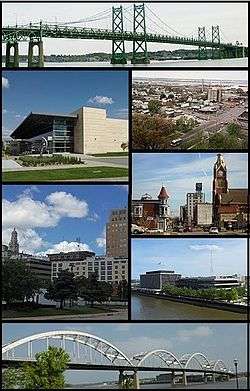 | |
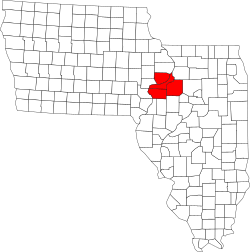 | |
| Coordinates: 41°31′00″N 90°32′00″W | |
| Country | United States |
| State(s) | Iowa Illinois |
| Largest city | Davenport, Iowa |
| Other cities | Moline, Illinois Rock Island, Illinois Bettendorf, Iowa East Moline, Illinois |
| Area | |
| • Total | 170 sq mi (400 km2) |
| Highest elevation | 850 ft (259 m) |
| Lowest elevation | 590 ft (180 m) |
| Population | |
| • Total | 383,681 |
| • Rank | 136th in the U.S. |
| • Density | 1,600/sq mi (618/km2) |
History
Early history
Before European settlers came to inhabit the Quad Cities, the confluence of rivers had attracted many varying cultures of indigenous peoples, who used the waterways and riverbanks for their settlements for thousands of years. At the time of European encounter, it was a home and principal trading place of the Sauk and Fox tribes of Native Americans. Saukenuk was the principal village of the Sauk tribe and birthplace of its 19th-century war chief, Black Hawk. In 1832, Sauk chief Keokuk and General Winfield Scott signed a treaty in Davenport after the US defeated the Sauk and their allies in the Black Hawk War. The treaty resulted in the Native Americans ceding 6 million acres (24,000 km2) of land to the United States in exchange for a much smaller reservation elsewhere. Black Hawk State Historic Site in Rock Island preserves part of historic Saukenuk and is listed on the National Register of Historic Places.
The history of urban settlements in the Quad Cities was stimulated by riverboat traffic. For 14 miles (23 km) between LeClaire, Iowa, and Rock Island, the Mississippi River flowed across a series of finger-like rock projections protruding from either bank. These rapids were difficult for steamboats to traverse. As demand for river-based transportation increased along the upper Mississippi, the navigability of the river throughout the "Rock Island Rapids" became a greater concern. Over time, a minor industry grew up in the area to meet the steamboats' needs. Boat crews needed rest areas to stop before encountering the rapids, places to hire expert pilots such as Phillip Suiter, who was the first licensed pilot on the upper Mississippi River, to guide the boat through the rocky waters, or, when the water was low, places where goods could be removed and transported by wagon on land past the rapids.[8] Today, the rocks are submerged six feet underwater by a lake formed by two locks and dams.
As the Industrial Revolution developed in the United States, many enterprising industrialists looked to the Mississippi River as a promising source of water power. The combination of energy and easy access to river transportation attracted entrepreneurs and industrialists to the Quad Cities for development. In 1848, John Deere moved his plough business to Moline. His business was incorporated as Deere & Company in 1868. Deere & Company is the largest employer today in the Quad Cities.
The first railroad bridge built across the Mississippi River connected Davenport and Rock Island in 1856. It was built by the Rock Island Railroad Company, and replaced the slow seasonal ferry service and winter ice bridges as the primary modes of transportation across the river. Steamboaters saw the nationwide railroads as a threat to their business. On May 6, 1856, just weeks after completion of the bridge, an angry steamboater crashed the Effie Afton into it. John Hurd, the owner of the Effie Afton, filed a lawsuit against the Rock Island Railroad Company. The Rock Island Railroad Company selected Abraham Lincoln as their trial lawyer and won after he took the case to the US Supreme Court. Phillip Suiter was one of his expert witnesses. It was a pivotal trial in Lincoln's career.
Evolution of an identity
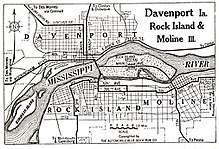
After the Civil War, the region began to gain a common identity. The river towns that were thoughtfully planned and competently led flourished, while other settlements, usually get-rich-quick schemes for speculators, failed to pan out. By World War I, the towns of Davenport, Rock Island, and Moline had begun to style themselves as the "Tri-Cities," a cluster of three more-or-less equally-sized river communities growing around the small bend of the Mississippi River where it flows west. But with the growth of Rock Island County, during the 1930s the term "Quad Cities" came into vogue, as East Moline was given "equal status." Despite the fact that the region had earned the name "Quad Cities," the National Basketball Association had a franchise in Moline, Illinois, from 1946 to 1951 called the "Tri-Cities Blackhawks." Then, with the opening of an Alcoa (now Arconic) plant east of Davenport in 1948, the town of Bettendorf underwent so much growth that many people in the community discussed the adoption of the name "Quint Cities",[9] But by this time, the name "Quad Cities" had become known well beyond the area, and "Quint Cities" never caught on, despite the efforts of WOC-TV (as KWQC-TV was then called) and others. Consequently, when Bettendorf passed East Moline in size, there was some debate about whether Bettendorf had "displaced" East Moline. Instead, local officials, such as the Chamber of Commerce,[10] have chosen an inclusive approach, maintaining the name "Quad Cities" yet including all five cities.[11]
1980s–current
Beginning in the late 1970s, economic conditions caused major industrial restructuring, which disrupted the basis of the region's economy. The major companies, agricultural manufacturers, ceased or scaled back operations in the Quad Cities. Factories which closed included International Harvester in Rock Island and Case IH in Bettendorf. Moline-based John Deere cut its labor headcount by one half. Later in the 1980s, Caterpillar Inc. closed its factories at Mount Joy and Bettendorf.
Since the 1990s, the Quad Cities governments, businesses, non-profits and residents have worked hard to redevelop the region. They have achieved national attention for their accomplishments.
Examples of revitalization and rebirth include:
- Davenport's River Renaissance (a downtown revitalization project that includes a river music history center), an ag-tech venture capital campus, and the Figge Art Museum opened or were completed during the first decade of the 21st century.
- Moline has invested in what was once a robust downtown. The "John Deere Commons" and TaxSlayer Center (formerly "The MARK of the Quad Cities" and the "iWireless Center") both opened during the 1990s.
- In 2007, Davenport and Rock Island competed for and won the title of "most livable small city" from the National Council of Mayors, based upon an unfunded proposal called RiverVision.
- In 2008 Bettendorf was ranked by CNN[12] as one of the ten best places to buy a house in the United States.
- In 2010, the Quad Cities were named "the most affordable metro" by Forbes magazine.[13]
- In 2012, Davenport housing market ranked second in the nation beating the housing bubble, due to its lack of foreclosures and their low unemployment.[14]
- In 2012, the Quad Cities Metropolitan Area was ranked among the fastest-growing areas in the nation in the growth of high-tech jobs.[15]
- In 2012, the Quad Cities were named the "2012 All American City"
- In 2013, Modern Woodman Park was voted the best minor league ballpark in America.[16]
Proposed mergers
Over the years, several communities in the Quad City area have proposed or performed mergers. As it grew, Davenport annexed the communities of Rockingham, Nahant, Probstei, East Davenport, Oakdale, Cawiezeel, Blackhawk, Mt. Joy, Green Tree, and others. Bettendorf annexed portions of Pleasant Valley in the 1970s. In 1987, Rock Island, Moline, East Moline, Milan, Carbon Cliff, Hampton, Coal Valley and Silvis considered a super-city merger which would have seen the Illinois cities become the second-largest city in the state,[17] but the proposal ultimately failed. Moline and East Moline considered a merger in 1997.[18] That same year, Green Rock and Colona did merge.[19]
Geography
The Quad Cities is located at the confluence of the Rock and Mississippi rivers, approximately 140 miles (230 km) west of Chicago, and form the largest metropolitan area along the Mississippi River between Minneapolis–Saint Paul and the St. Louis metropolitan area. Interstate 80 crosses the Mississippi River here. The Quad Cities area is distinctive because the Mississippi River flows from east to west as it passes through the heart of the area; the Iowa cities of Davenport and Bettendorf are located due north of Rock Island and Moline, respectively.
The Quad Cities area is one where the telephone companies cooperate with regional phone calls. Iowa and Illinois have different area codes (563 and 309 respectively), yet most calls originating and terminating within the core urban area are placed without long-distance charges by dialing just a 7-digit number. This helps the bi-state area promote itself as a single community, "joined by a river."
The Quad Cities Metropolitan Area consists of three counties: Scott County in Iowa, and Rock Island County and Henry County in Illinois. The Quad City metro population is 382,268.[20] The Quad Cities Metropolitan Area is also considered part of the Great Lakes Megalopolis.[21][22]
| Climate data for Quad Cities (Quad City International Airport), 1981–2010 normals, extremes 1871–present[lower-alpha 1] | |||||||||||||
|---|---|---|---|---|---|---|---|---|---|---|---|---|---|
| Month | Jan | Feb | Mar | Apr | May | Jun | Jul | Aug | Sep | Oct | Nov | Dec | Year |
| Record high °F (°C) | 69 (21) |
74 (23) |
88 (31) |
93 (34) |
104 (40) |
104 (40) |
111 (44) |
106 (41) |
100 (38) |
95 (35) |
80 (27) |
71 (22) |
111 (44) |
| Average high °F (°C) | 31.0 (−0.6) |
35.7 (2.1) |
48.8 (9.3) |
62.3 (16.8) |
72.9 (22.7) |
82.3 (27.9) |
85.8 (29.9) |
83.8 (28.8) |
76.8 (24.9) |
64.1 (17.8) |
49.2 (9.6) |
34.6 (1.4) |
60.7 (15.9) |
| Average low °F (°C) | 14.3 (−9.8) |
18.3 (−7.6) |
29.4 (−1.4) |
40.5 (4.7) |
50.7 (10.4) |
60.7 (15.9) |
65.0 (18.3) |
63.2 (17.3) |
53.9 (12.2) |
42.4 (5.8) |
30.9 (−0.6) |
18.6 (−7.4) |
40.8 (4.9) |
| Record low °F (°C) | −33 (−36) |
−28 (−33) |
−19 (−28) |
7 (−14) |
25 (−4) |
39 (4) |
46 (8) |
40 (4) |
24 (−4) |
11 (−12) |
−10 (−23) |
−24 (−31) |
−33 (−36) |
| Average precipitation inches (mm) | 1.49 (38) |
1.60 (41) |
2.86 (73) |
3.59 (91) |
4.32 (110) |
4.49 (114) |
4.29 (109) |
4.52 (115) |
3.09 (78) |
2.97 (75) |
2.56 (65) |
2.18 (55) |
37.96 (964) |
| Average snowfall inches (cm) | 9.4 (24) |
6.8 (17) |
4.0 (10) |
0.9 (2.3) |
0 (0) |
0 (0) |
0 (0) |
0 (0) |
0 (0) |
0 (0) |
1.2 (3.0) |
9.3 (24) |
31.6 (80) |
| Average precipitation days (≥ 0.01 in) | 8.8 | 8.3 | 10.1 | 11.0 | 11.7 | 10.5 | 9.8 | 9.8 | 8.2 | 9.1 | 9.8 | 10.0 | 117.1 |
| Average snowy days (≥ 0.1 in) | 7.1 | 5.6 | 3.2 | 0.7 | 0 | 0 | 0 | 0 | 0 | 0 | 1.7 | 6.8 | 25.1 |
| Average relative humidity (%) | 69.9 | 69.8 | 68.3 | 64.3 | 64.9 | 65.8 | 70.5 | 73.3 | 72.8 | 68.1 | 71.3 | 74.0 | 69.4 |
| Mean monthly sunshine hours | 148.1 | 153.8 | 180.5 | 210.1 | 255.1 | 284.6 | 301.9 | 271.4 | 222.0 | 192.9 | 121.7 | 113.9 | 2,456 |
| Percent possible sunshine | 50 | 52 | 49 | 53 | 57 | 63 | 66 | 63 | 59 | 56 | 41 | 40 | 55 |
| Source: NOAA (relative humidity and sun 1961−1990)[23][24][25] | |||||||||||||
Demographics
According to the 2010 United States Census estimate, the metropolitan area grew to 471,551 (error: Number quoted is from the 2010 CSA count).[26] As of the 2000 census, a total of 96,495 households and 60,535 families resided in the area.
Race and ethnicity
The racial makeup of the area is 90.6% White (410,861), 3.7% Black or African American (27,757), 0.6% American Indian and Alaskan Native (1,255), 1.0% Asian (6,624), 0.03% Pacific Islander (156), and 2.0% from two or more races (11,929). 7.1% of the population is Hispanic or Latino of any race (37,070).[27] The predominant ethnicities in the Quad Cities are of northern European descent, including German, Irish, and English, as well Scandinavian (Mostly Swedish and Norwegian) and Dutch.[28][29][30][31][32] The primary minority groups in the area are African-Americans, which in Davenport make up the third largest black population in the state of Iowa, a community dating back to the 1830s when Iowa was a free territory. Many of the city's African-American residents have roots in the Southern/Border states of the U.S., including Mississippi, Arkansas, Alabama, and Missouri. The most significant Asian-American populations are South Asian and Vietnamese American.[33][34][35][36]
Religion
According to resources, Christianity is the largest religion to be practiced in the area. However, the two states have a different population of Christian groups. In Davenport and Bettendorf, Catholics make up an 18.5% plurality, but Protestants with 15.1% Mainline and 11.6% Evangelical make up large minorities as well. The Black Protestants on the Iowa side comes in at 1.2%. On the Illinois side, between Rock Island, Moline, and East Moline, Catholicism is less prevalent at 12.4%, and at 12.5% Evangelical and 11.0% Mainline have smaller declines.[28][29][30][31][32]
The Jewish population is about 500–600, which is down from about 1,800–2,000 in the 1950s and 1960s.[37]
Landmarks

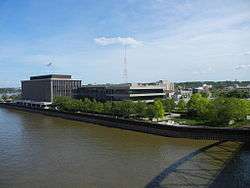
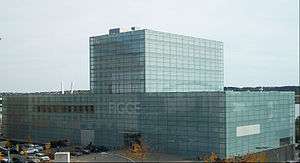
- The business Antique Archeology, featured on the History Channel show American Pickers, is located in LeClaire
- Brady Street Stadium, a major high-school sports venue along Davenport's Brady Street (U.S. 61)
- The Col Ballroom, a small arena for music concerts, in Davenport
- Davenport Skybridge
- Figge Art Museum, Davenport, formerly the Davenport Museum of Art, designed by British architect David Chipperfield and opened in 2005. Its holdings include extensive collections of Haitian, colonial Mexican and Midwestern art, particularly pieces by Thomas Hart Benton, Marvin Cone and Grant Wood, and personal effects from Wood's estate.
- Fred Schwengel Memorial Bridge, a four-lane steel-girder bridge on Interstate 80, crossing the Mississippi River to connect LeClaire and Rapids City. Opened in 1966.
- Government Bridge, a double-decked bridge adjacent to Lock and Dam 15, carrying motor and rail traffic between Arsenal Island and Davenport. The 1896 truss bridge, about 1,950 feet long, includes a 360-degree swing span over the twin locks. It connects to the Illinois side of the river via the Rock Island Viaduct.
- Iowa 80 Truck Stop – the world's largest truck stop is along Interstate 80 near Walcott, Iowa, west of Davenport.
- Interstate 74 Bridge, formerly known as the "Iowa-Illinois Memorial Bridge", connecting Bettendorf and Moline. The twin suspension spans across the Mississippi River were built in 1935 and 1959 and adapted to carry Interstate 74 in the early 1970s. The twinned towers are a symbol of the two-state Quad Cities community. The bridge is set to be replaced with eight lanes.
- John Deere Pavilion, a small museum and showcase for John Deere equipment, built adjacent to the John Deere Commons in the 1990s in downtown Moline.
- John Deere World Headquarters, designed by Eero Saarinen and completed in 1963 in Moline.
- The John Looney Mansion, designed and built in 1897 for the attorney, publisher and gangster John Looney in Rock Island which still stands off 20th Street and 17th Avenue.
- Lock and Dam No. 15, a 1,200-foot roller dam with twin locks across the Mississippi River between Arsenal Island and Davenport. The roller dam, billed as the longest of its type, maintains a pool upstream that allows river traffic to pass through the once notorious Rock Island Rapids.
- Mississippi Valley Fairgrounds, a fair and exposition venue in Davenport
- Modern Woodmen Park, formerly John O'Donnell Stadium, home of the Houston Astros' class A affiliate, the Quad Cities River Bandits, on the Davenport riverfront. With the lights of Rock Island across the Mississippi and the Centennial Bridge looming just beyond the right-field fence, the park was named by USA Today as one of 10 great places for a baseball pilgrimage. The ball park added a 110 ft. ferris wheel before the start of the 2014 season.
- Old Main, completed in 1888, the oldest building on the campus of Augustana College. Located on a bluff overlooking the Mississippi River, its iconic and newly renovated dome was lighted as of October 2011.
- Putnam Museum in Davenport
- Quad City Botanical Center in Rock Island
- Quad Cities Waterfront Convention Center, located in Bettendorf
- RiverCenter/Adler Theatre, a convention and performing-arts complex in Davenport. The 2,400-seat Adler is the former RKO Orpheum Theater, which opened in 1931, designed by A.S. Graven of Chicago, whose projects included the Drake Hotel in Chicago and the Paramount Theater in New York City. The theater was extensively renovated and expanded in 1984–86 and 2005.
- River Music Experience, a performance, education and music-history venue in the Redstone Building, the former Petersen Harned Von Maur department store
- Rock Island Arsenal, manufacturer of military equipment and ordnance since the 1880s, now the largest government-owned weapons manufacturing arsenal in the United States. The arsenal is located on Arsenal Island (formerly known as Rock Island) in the Mississippi River between Davenport, Iowa, and Rock Island, Illinois. Fort Armstrong was built there in 1816. During the civil war, the island held a Union prison camp for Confederate soldiers. The Federal-style home of Colonel George Davenport, built in 1833–34, the oldest extant building in the Quad Cities, is on the north bank of the island.
- Rock Island Centennial Bridge over the Mississippi River between downtown Davenport and Rock Island, completed in 1940 to commemorate Rock Island's 100th anniversary. The five arches of the 3,853-foot through-arch bridge often are used as a symbol of the Quad Cities.
- Rock Island County Fairgrounds in East Moline, also the site of the Quad City Speedway
- Rock Island Auction Company from the Discovery Channel show Ready, Aim, Sold![38]
- TaxSlayer Center – 11,000-seat arena in Moline (formerly The Mark of the Quad Cities and the iWireless Center).
- Vander Veer Botanical Park is a 33-acre (130,000 m2) botanical garden in the Vander Veer Park Historic District of Davenport, Iowa. It is believed to be one of the first botanical parks west of the Mississippi River.[39]
- The Quarter – a 90-acre (360,000 m2) site in East Moline, alongside the Mississippi River, featuring shops, restaurants, condominiums, boat docks, sports and interpretive centers, and a working lighthouse, currently under development. (Geographical coordinates: 41°31′47″N 90°26′16″W)[40]
- Chicago, Milwaukee, St. Paul and Pacific Freight House, referred to locally as the "Freight House", is an entertainment venue
- TBK Bank Sports Complex, also known as the BettPlex, is a state-of-the-art sport and entertainment complex. Containing eight full-size volleyball and basketball courts. Four indoor and five outdoor sand volleyball courts, 10 lighted outdoor baseball and softball fields, the BettPlex is a 45 million dollar sporting facility that was created to host weekend sporting tournaments in the Quad Cities.
Noteworthy companies
- Arconic
- Cobham plc
- Deere & Company (also known as/branded: John Deere)
- Genesis Health System
- Group O
- Guardian Industries
- Happy Joe's
- KONE, Inc (formerly Montgomery Elevator)
- Lee Enterprises
- Lewis Machine and Tool Company
- Modern Woodmen of America
- Nestlé Purina PetCare
- QCR Holdings
- Sears Seating (also known as Sears Manufacturing)
- Von Maur
- Whitey's Ice Cream
Top employers
According to Quad Cities website,[41] the top employers in the Quad Cities area are:
| Rank | Employer | # of employees | Industry |
|---|---|---|---|
| 1 | Deere & Company | 7,240 | Agricultural Innovation |
| 2 | Rock Island Arsenal | 6,163 | Defense Manufacturing |
| 3 | Genesis Health System | 5,173 | Healthcare |
| 4 | Hy-Vee | 4,568 | Grocery |
| 5 | UnityPoint Health - Trinity | 3,954 | Healthcare |
| 6 | HNI Corporation/The Hon Company/Allsteel | 3,200 | Office Furniture Manufacturing |
| 7 | Walmart | 2,821 | Warehouse Clubs and Supercenters |
| 8 | Arconic | 2,500 | Aerospace and Defense Aluminum |
| 9 | Tyson Fresh Meats | 2,400 | Food Processing |
| 10 | Oscar Mayer/Kraft | 1,600 | Food Processing |
Notable people
|
Alphabetical by first name
|
|
Education
Colleges and universities
- Augustana College – A private, four-year liberal arts college in Rock Island.
- Bible Missionary Institute – A Bible college in Rock Island affiliated with the Bible Missionary Church.
- Black Hawk College – Community college in Moline, with a satellite campus in Kewanee, Illinois.
- Eastern Iowa Community College District – Consisting of campuses in Bettendorf, Clinton, and Muscatine. Bettendorf's campus is known as Scott Community College.
- Palmer Chiropractic College – Davenport, first chiropractic school in the world.
- Saint Ambrose University- A university in Davenport.
- Upper Iowa University – A satellite campus in Bettendorf.
- Western Illinois University-Quad Cities – A satellite campus district in Moline being constructed along the riverfront at the former site of the 60,000-square-foot (5,600 m2) John Deere Technical Site.
Culture
Since 1916, the region has supported the Quad City Symphony Orchestra, which presents a year-round schedule of concerts at the Adler Theatre in Davenport and Centennial Hall in Rock Island. The Handel Oratorio Society, dating to 1880, is the second-oldest organization of its kind in the nation and presents annual performances of "Messiah" along with another major work for choir and orchestra. The Augustana Choir, founded at Rock Island's Augustana College in 1934, is one of the nation's leading collegiate choruses. Major outdoor summer music festivals include the Bix Beiderbecke Memorial Jazz Festival, Mississippi Valley Blues Festival, and River Roots Live.
The Quad Cities' three traditional community theaters – Playcrafters Barn Theatre (founded in 1920, comedies and dramas)[42] and Quad City Music Guild (1948, musicals) in Moline, and Genesius guild (1957, outdoor Shakespeare and Greek comedies and tragedies) in Rock Island – were joined in 1976 by Circa '21 Dinner Playhouse, a professional dinner theater in downtown Rock Island's historic Fort Theatre. Ballet is performed at Ballet Quad Cities. ComedySportz provides improv comedy. Bluebox Limited is a Bettendorf-based film production company, and many outside productions companies have filmed movies in the Quad Cities in recent years. Historic buildings and sites listed on state and the National Register of Historic Places interpret the history of people's settlement and lives in the area.
Media
The Quad Cities is the 151st largest radio market in the United States.[43] It is ranked 97th by Nielsen Media Research for the 2008–09 television season with 309,600 television households.[44]
The area is served by over 13 commercial radio stations, 8 non-commercial radio stations, 3 low power FM radio stations, 8 TV stations and 3 daily newspapers.
In 2012, the Mississippi Valley Fair that is held in Davenport served as the film location for Rodney Atkins' music video "Just Wanna Rock N' Roll."
Also in 2012, the PBS Frontline documentary Poor Kids was filmed in and around the Quad Cities showing poverty from a child's perspective.
Transportation

Four interstate highways serve the Quad Cities: Interstate 80, Interstate 280, Interstate 74 serve both states while Interstate 88 serves just Illinois. United States highways include U.S. Route 6 and U.S. Route 67 which run through both Iowa and Illinois, while U.S. Route 61 serves just Iowa and U.S. Route 150 serves just Illinois. A total of five bridges accessible by automobiles connect Iowa with Illinois in the Quad Cities across the Mississippi River. The Fred Schwengel Memorial Bridge carries Interstate 80 and connects Le Claire, Iowa, with Rapids City, Illinois. Continuing downstream, the I-74 Bridge connects Bettendorf, Iowa, with Moline, Illinois, and is the busiest bridge with an average of 70,400 cars a day.[45] The Government Bridge connects Downtown Davenport with the Rock Island Arsenal. Three bridges connect Davenport with Rock Island, Illinois; The Rock Island Centennial Bridge, The Crescent Rail Bridge, and the furthest downstream bridge, the Sergeant John F. Baker, Jr. Bridge which carries I-280.
Several state highways also serve the area. Iowa Highway 22 is on Davenport's southwest side and runs west through the county, while Iowa Highway 130 runs along Northwest Boulevard on Davenport's north edge. Illinois Route 5 (John Deere Road) runs from Rock Island east till it runs into Interstate 88. Illinois Route 92 runs along the Mississippi River, while Illinois Route 84 runs along the east side of Rock Island County. Illinois Route 192 connects Highway 92 with Illinois Route 94 near Taylor Ridge. The Chicago – Kansas City Expressway also serves the area along Interstates 74, 80, and 88.
There are three transit operators in the Quad Cities with limited interconnection between them. Rock Island County Metropolitan Mass Transit District (Quad Cities MetroLINK) serves the Illinois cities of Rock Island, Moline, East Moline, Milan, Silvis, Carbon Cliff, Hampton and Colona. It has 12 routes and a fleet of about 52 buses. It operates a river craft during summer months. In Iowa, Davenport Citibus has 10 fixed routes and operates 20 buses, seven days a week and Bettendorf Transit operates three routes, Monday–Saturday, and has eight buses.
Amtrak currently does not serve the Quad Cities. The closest station is about 50 miles (80 km) away in Galesburg, Illinois. In 2008, the two current United States Senators from Iowa, Tom Harkin and Chuck Grassley, Illinois Senator Dick Durbin, and former President Barack Obama sent a letter to Amtrak asking them to begin plans to bring rail service to the Quad Cities.[46] In October 2010, a $230 million federal fund was announced that will bring Amtrak service to the Quad Cities, with a new line running from Moline to Chicago. They hoped to have the line completed in 2015, and offer two round trips daily to Chicago.[47]
In December 2011, the federal government awarded $177 million in funding for the Amtrak connection. Budgetary and logistical issues have delayed the completion of all necessary track improvements, but the project is still in development.[48][49] The multi-modal Moline Q Station building was completed in early 2018, with the attached Westin Element hotel opening in February.[50] When the full project is completed, it will establish passenger rail through the Quad Cities, for the first time since the 1970s.
The Quad Cities is served by the Quad City International Airport, Illinois' third-busiest airport, located in Moline. The airport is marketed as a regional alternative to the larger airports in Chicago, nearly 200 miles (320 km) away. The smaller Davenport Municipal Airport is the home of the Quad City Air Show.
Sports
From 1907 to 1926, Rock Island was home to the NFL's Rock Island Independents. The franchise was a charter member on the National Football League (NFL) in 1920. The first NFL Game ever was played by the Islanders at Douglas Park in September 1920. Football legend Jim Thorpe was a member of the team in 1924.
The Tri-Cities Blackhawks, named in honor of the Sauk war chief Black Hawk, was the next top-level professional sports franchise. The club played in the National Basketball League (NBL) from 1946 until its merger in 1949 with the Basketball Association of America to become the National Basketball Association (NBA). Hall of famer Red Auerbach coached the Blackhawks during their first NBA season.
After the 1950–51 basketball season, the team moved to Milwaukee, where they were named the Hawks. After a second move to St. Louis, the team is now the Atlanta Hawks.
Professional basketball returned to the Quad Cities during the 1980s and 1990s with the Quad City Thunder of the Continental Basketball Association. The CBA served as the NBA's premier developmental league and produced many highly regarded NBA stars. From 1987 through the 1992–93 season, the Thunder played at Wharton Field House in Moline. Starting with the 1993–94 season, the team played at The MARK of the Quad Cities (now the TaxSlayer Center.) After the CBA folded in 2001, the Thunder franchise ceased operations permanently. The TaxSlayer Center occasionally hosts NCAA Division I college basketball conference tournaments as well as NBA and NHL exhibitions.
The Quad Cities has hosted minor league baseball teams since the Davenport Brown Stockings first played in 1878. The Rock Island Islanders and Moline Plowboys each fielded teams for many seasons. The Islanders began play in 1901and played primarily at Douglas Park. The Plowboys were founded in 1914. Their home was Browning Field.
The Davenport franchise has been a member of the Midwest League since 1960. They have played at Modern Woodman Park since 1931. Today, the Quad Cities River Bandits are a Class A affiliate of the Houston Astros.
The PGA Tour makes an annual stop in the Quad Cities. The golf tournament is currently known as the John Deere Classic. It has drawn dozens of top PGA players over the years, including Tiger Woods, Vijay Singh, and Payne Stewart.
The Quad Cities Marathon has run annually in late September since 1998. Roughly 400-500 participants race through the four cities, beginning and ending in Moline. The race weekend also offers a half marathon and a 5K as well as races for children. Kenyan Kiplangat Terer holds the men's record with a 2:14:04, run in 2013. Ethiopian Hirut Guangul holds the woman's record at 2:35:07, from her 2012 win.[51]
Sports teams
| Club | Sport | League | Venue | Established | Championships |
|---|---|---|---|---|---|
| Quad Cities River Bandits | Baseball | MWL | Modern Woodmen Park | 1960 | 6 |
| Quad City Steamwheelers | Indoor football | IFL | TaxSlayer Center | 2017 | 0 |
| Quad City Storm | Ice hockey | SPHL | TaxSlayer Center | 2018 | 0 |
- Quad City River Bandits is a Class A Midwest League minor league baseball team in Davenport. Their home games are played at Modern Woodmen Park, formerly John O'Donnell Stadium. The Davenport team has existed under a variety of names and Major League Baseball team affiliations since 1901. The River Bandits are currently affiliated with the Houston Astros.
- Quad City Mallards were an ice hockey team that played from 2009 to 2018 with home games held at the TaxSlayer Center in Moline. The new Mallards replaced the former Quad City Flames AHL team which played from 2007 to 2009. The original Mallards played in the United Hockey League from 1995 to 2007.
- The Quad City Storm was launched for the 2018–19 season in the Southern Professional Hockey League.[52]
- The Quad City Steamwheelers were an AF2 arena football franchise that also played at the TaxSlayer Center. The Steamwheelers won the league's title game, the ArenaCup, in 2000 and 2001. After the AF2 league folded following its 2009 season, the Steamwheelers also ceased operations.
- A new Quad City Steamwheelers organization launched for the 2018 season in Champions Indoor Football and then moved to the Indoor Football League for 2019.[53]
- Quad City Silverbacks were a professional mixed martial arts team competing in the now-defunct International Fight League. Home matches took place at the iWireless Center.
- Pat Miletich formed and based a mixed martial arts gym and fight team, Miletich Fighting Systems, in the Quad Cities. Miletich Fighting Systems is among MMA's first 'super-camps', and housed many of the consensus greatest fighters of the early 2000s, such as Jens Pulver, Matt Hughes, Robbie Lawler, Tim Sylvia, and Jeremy Horn, among others.
- The Quad City Riverhawks was a PBL (Premier Basketball League) team. They played home games at Wharton Field House in Moline during the 2008 season. They ended with that season. Previously, the Quad City Thunder were a CBA team playing in the late 1980s thru 2000, first at Wharton and then at The Mark.
- The Quad City Raiders are a semi-professional minor league football team that was formed in 2011 to serve the Quad City area. The Raiders play in the MidStates Football League and have reached the semi-finals in the league playoffs each season.[54]
See also
- Mississippi Athletic Conference for Iowa high school sports, and Western Big 6 Conference for high school sports in Illinois.
See also
- African Americans in Davenport, Iowa
- Wild Dog (comics)
- Quad City-style pizza
- List of tallest buildings in the Quad Cities
- Happy Joe's Pizza Parlor Chain with headquarters in Bettendorf, Iowa
- Whitey's Ice Cream Parlor Chain with headquarters in Moline, Illinois
Notes
- Official precipitation records for the Quad Cities kept at the Weather Bureau Office (WBO) in Davenport, Iowa from July 1871 to December 1931, alternating between Quad City Int'l (KMLI) and the Davenport WBO from January 1932 to 17 February 1937, and remaining at KMLI since 18 February 1937. Temperature, snowfall, and snow depth records date to 1 January 1874, 1 August 1882, and 1 January 1901, respectively. For more information, see Threadex
References
- "Welcome to the Quad Cities". City Guide Post Inc. Retrieved February 2, 2008.
- "Community Visitor Information". Illinois Quad Cites Chamber of Commerce. Archived from the original on December 14, 2007. Retrieved February 2, 2008.
- Johnson, Dirk (October 20, 1987). The New York Times https://query.nytimes.com/gst/fullpage.html?res=9B0DE3DD1531F933A15753C1A961948260. Retrieved February 2, 2008. Missing or empty
|title=(help) - "Why Quad Cities". Quad Cities Chamber of Commerce. Archived from the original on January 19, 2016. Retrieved February 3, 2016.
- List of Combined Statistical Areas
- "Annual Estimates of the Population of Metropolitan and Micropolitan Statistical Areas: April 1, 2010 to July 1". 2011 Population Estimates. United States Census Bureau, Population Division. June 2012. Archived from the original (CSV) on April 27, 2012. Retrieved August 1, 2012.
- "Annual Estimates of the Population of Metropolitan and Micropolitan Statistical Areas: April 1, 2010 to July 1, 2011". 2012 Population Estimates. United States Census Bureau, Population Division. April 2012. Archived from the original (CSV) on May 1, 2013. Retrieved March 16, 2013.
- Frederick Anderson, ed. Joined by a River: The Quad Cities, Lee Enterprises, Inc., 1982, p. 16.CS1 maint: extra text: authors list (link)
- "About". 2008-09-19. Retrieved February 3, 2016.
- "Quad Cities Chamber". Quad Cities Chamber. Retrieved July 25, 2018.
- "Cities". September 20, 2008. Archived from the original on July 26, 2018. Retrieved July 25, 2018.
- Cox, Jeff. "CNN; Where homes are affordable". Retrieved September 24, 2008.
- "The Best Places for Business and Careers - 2015". Forbes.
- "5 Markets Beating the Housing Bust". Yahoo Finance. February 23, 2012. Retrieved February 3, 2016.
- Doug Schorpp. "Study: Q-C makes strides in high-tech jobs". The Quad-City Times. Retrieved February 3, 2016.
- "Modern Woodmen Park voted Best Minor League Ballpark – MiLB.com Clubs". MiLB.com. Retrieved February 3, 2016.
- Schmeltzer, John (1987-08-19). "Quad Cities Toying with Supercity Idea". Chicago Tribune. Retrieved 11 August 2019.
- Morris, Rebecca (1997-08-27). "MOLINE, EAST MOLINE DISCUSS MERGER". Dispatch-Argus. Retrieved 11 August 2019.
- Lemmon, Dustin (2007-06-24). "10 years later: Merger 'best' for Green Rock, Colona". Quad City Times. Retrieved 11 August 2019.
- "U.S. Census website". United States Census Bureau. 2016. Retrieved July 17, 2017.
- America 2050: Megaregions: Great Lakes. Regional Plan Association.
- Regional Plan Association (2008). America 2050: An Infrastructure Vision for 21st Century America. New York: Regional Plan Association.
- "NowData - NOAA Online Weather Data". National Oceanic and Atmospheric Administration. Retrieved 2019-02-01.
- "Station Name: IL MOLINE QUAD CITY INTL AP". National Oceanic and Atmospheric Administration. Retrieved 2019-02-01.
- "WMO Climate Normals for MOLINE/QUAD CITY, IL 1961–1990". National Oceanic and Atmospheric Administration. Retrieved 2014-03-10.
- "American FactFinder". United States Census Bureau. 2010. Retrieved 2011-05-26. Note: Quad City population is equivalent to adding up the populations of Scott County, Iowa and Rock Island, Mercer, and Henry Counties in Illinois.
- https://www.quadcitieschamber.com/Quad%5B%5D Cities Chamber-Quad Cities Demographics.pdf
- "Davenport, Iowa".
- "Bettendorf, Iowa".
- "Rock Island, Illinois".
- "Moline, Illinois".
- "East Moline, Illinois".
- "Davenport Population and Demographics".
- "Bettendorf Population and Demographics".
- "Rock Island Population and Demographics".
- "Moline Population and Demographics".
- "Jews in the Quad Cities". Quad City Times.
- Alma Gaul. "TV show to feature RI auction business". The Quad-City Times. Retrieved February 3, 2016.
- Walters, Bruce (3 October 2013). "Art for the Quick and the Dead: Exploring the Sculptures of Quad Cities Cemeteries". River City Reader. Archived from the original on 30 July 2019. Retrieved 30 July 2019.
- City of East Moline Archived March 13, 2010, at the Wayback Machine
- "Largest Employers | Top Employers | QC First". Quadcitiesfirst.com. Archived from the original on 2019-03-31. Retrieved 2016-02-03.
- Virgo Multimedia (1960-10-05). "Playcrafters Barn Theatre – Community theater for the Quad-Cities". Playcrafters.com. Archived from the original on May 13, 2015. Retrieved 2016-02-03.
- "Market Survey Schedule & Population Rankings" (PDF). Arbitron. September 12, 2011. Archived from the original (PDF) on October 15, 2011. Retrieved September 12, 2011.
- Nielsen Media Research. "Nielsen Local Television Market Universe Estimates". Retrieved 2009-01-17.
- "Bridges: Iowa, Illinois order safety inspections". Quad City Times. Retrieved 2007-12-19.
- Coulter, Melissa (2008-06-06). "Ready to trade wheels for rails". Quad-City Times. Retrieved 2008-09-29.
- Tibbetts, Ed (2010-10-25). "Quad-City rail project to get $230 million". Quad City Times. Retrieved 2010-10-29.
- Wisniewski, Mary (19 November 2018). "Hopes rise for new passenger trains to Quad Cities, Dubuque". Chicago Tribune. Retrieved 14 January 2019.
- Ketz, Jonathan (8 August 2017). "No longer on track: what's delaying Quad Cities-to-Chicago passenger rail". WQAD Channel 8 News. Retrieved 14 January 2019.
- "Element Westin/The Q Project". Moline, IL Official Website. Retrieved 14 January 2019.
- "Quad Cities Marathon". QC Marathon. Retrieved 31 January 2020.
- "Storm's a coming: Quad-Cities hockey franchise unveils new name". The Dispatch / The Rock Island Argus. June 22, 2018.
- "Quad City Steamwheelers join the IFL for 2019 season". Nebraska.tv. 2018-09-07. Retrieved September 7, 2018.
- "ABOUT – Quad City Raiders". Qcraiders.com. Retrieved 2016-02-03.
External links
| Wikimedia Commons has media related to Quad Cities. |
| Wikivoyage has a travel guide for Quad Cities. |
- QuadCities.com – Local Information Guide, Business Directory, Event Calendar
- Quad Cities Convention & Visitors Bureau
- Quad City Times newspaper – Local News and Information
- Quad-Cities Online – Local Information
- WeAreQC. Quad City Resource. Built by the Quad Cities
- QCANews.com – Local News

